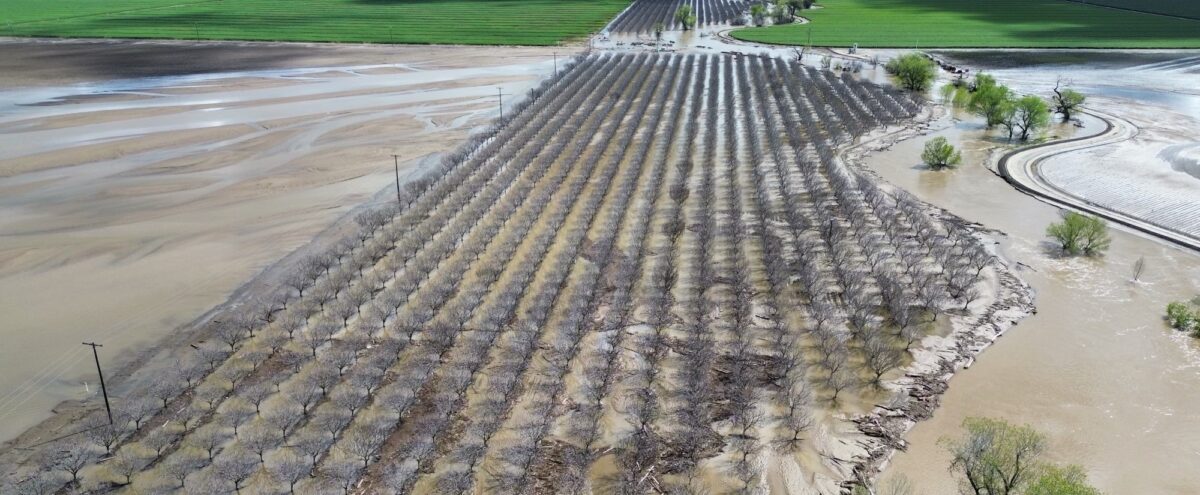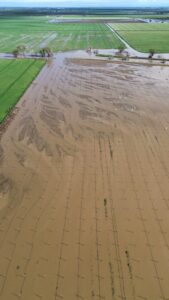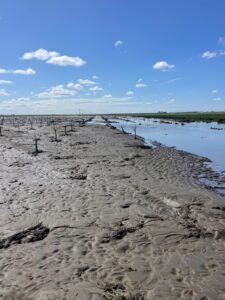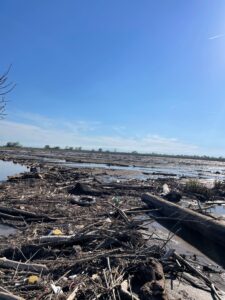
Flooding at this Tulare County farm along the Tule River between Tulare and Tipton has caused long-term damage to trees, a major investment for farmers. Image courtesy Schuil Ag Real Estate.
Written by Edward Smith
The $60 million estimate in damage to ag land in Tulare County from Gov. Gavin Newsom does not surprise real estate agent Jonathan Verhoeven, co-owner of Schuil Ag Real Estate.
“That would not shock me,” Verhoeven said.
On Mar. 28, Newsom penned a letter to President Joe Biden and the Federal Emergency Management Agency requesting additional resources to California counties affected by flooding.
Newsom requested FEMA to take on 100% cost share for private and public entities in Tulare and Monterey counties to remove debris and institute emergency protective measures. Other counties named in the letter were requested to be eligible for either public or private entities.

According to the letter, over 4,000 evacuation orders had been issued in Tulare County and over 9,000 warnings had been given at the worst of the flooding. Two homes had been destroyed, 101 had suffered major damage and 52 suffered minor damage. Because of “extensive flooding,” initial damage estimates to fields are at $60 million, but the letter notes that impacts will be even greater as unemployment levels will increase due to the effect flooding has had on ag land.
Officials estimate costs to remove debris and emergency protective measures throughout the state to be $156 million while damage to roads, bridges, water control facilities, public buildings and parks to be $368.27 million. Costs to FEMA for Calaveras, Los Angeles, Monterey and Tulare counties alone has already hit $92.2 million.
The first sense of damage to flooded land is beginning to make itself clear, but farmers “are still panicking about getting flooding under control,” he said.
Water has damaged in-field crops and sent massive amounts of debris and silt onto land.
Wheat planted in winter to feed cows is unable to be harvested and corn that should have been planted for summer feed can’t be planted in soaked ground, Verhoeven said.
As water eroded the land, it brought with it very fine silt, depositing the material in places where water had time to pool. Farmers now aren’t sure about how to deal with the massive build up whether they’ll have to scrape it up and move it elsewhere or till it into the ground, but it is not conducive to growing crops, Verhoeven said.

When it dries out, it can be blown up into the air, causing long-term respiratory issues.
But the force of the water brought more than silt. It also carried any kind of debris caught in its wake, damaging trees or lodging it in soil.
Trees have been underwater for days or even weeks in some areas.
How pistachios take to standing water is still not known, said Verhoeven, but almonds need sandy soil and oxygen in roots.
Citrus — largely dominating eastern Tulare County — is planted typically on higher ground, so it is possible it may not have as many damaged acres as nut groves.
Casey Creamer, president of California Citrus Mutual said the extent of damage on citrus is still unknown.
“Roots have been wet and we hope they get the opportunity to dry out soon,” Creamer said. “Next year’s crop could have impacts with bloom starting to happen.”
Harvesting has also been affected with wet weather keeping crews out from harvesting, Verhoeven said.
There may be some loans through the United States Department of Agriculture, said Verhoeven, but he doesn’t think crop insurance covers this type of disaster.
Crop insurance wouldn’t cover the long-term damage to trees suffered.
“There is a massive difference in the value of a single season’s crop and the long term damage that we can expect from these floods,” Verhoeven said.









